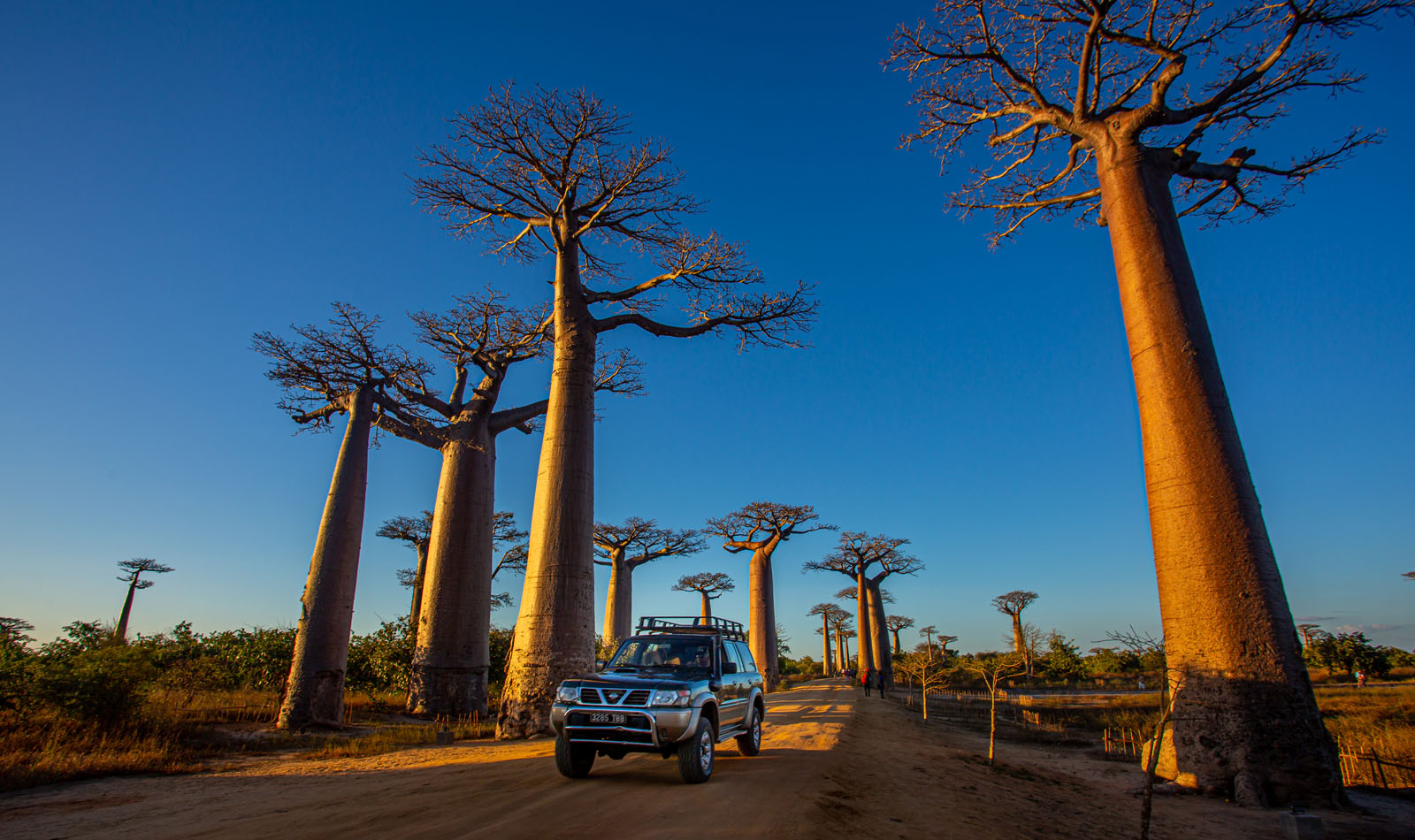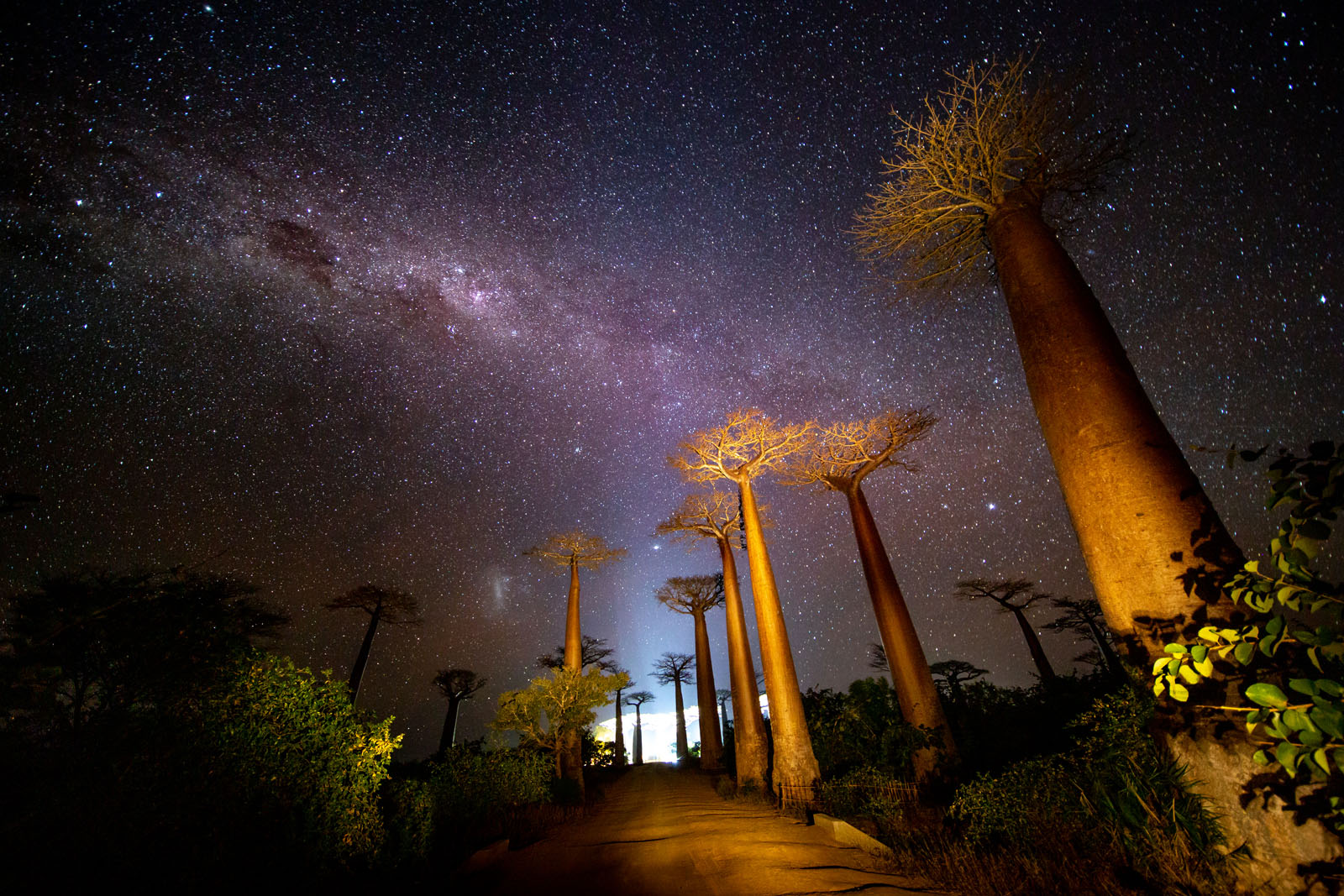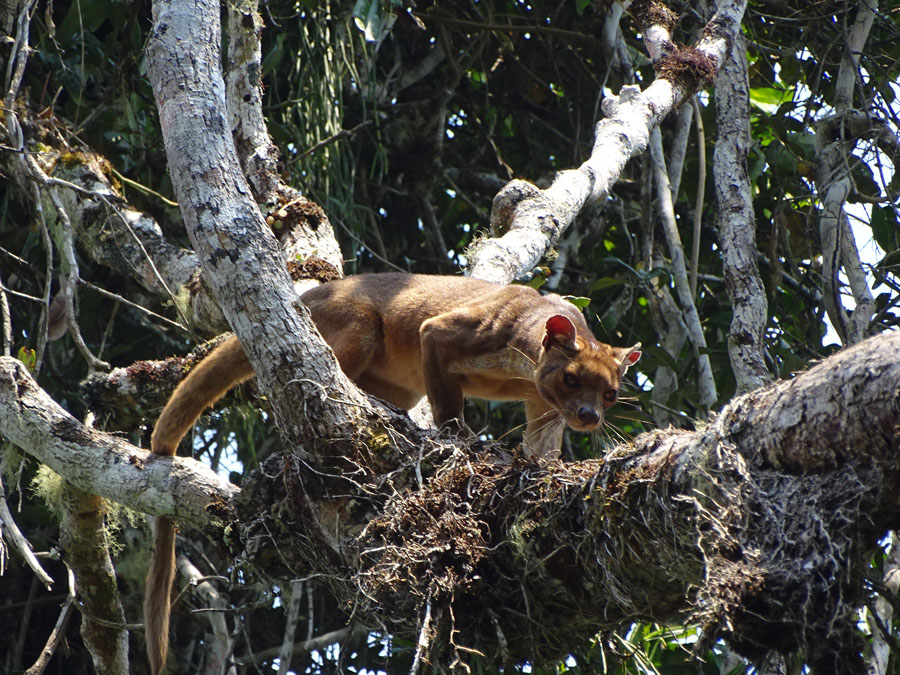(12 days/ 11 nights)
At the beginning classical southern tour, with a trip to Ranomafana and Isalo nationalparks. Then, flight via Tana to Morondava and drive by 4wd car through the famoused Baobab Avenue and visit of the Kirindy reserve.
Meeting at Ivato international airport and transfer to the city. Overnight at the hotel
ANTANANARIVO – MORONDAVA (flight only two to four times per week, tour must be adapted accordingly) – KIRINDY RESERVE
(45 km about 2 hours)
Flight to Morondava. Reception at the airport and drive directly through Baobab Alley to the Kirindy Reserve. By the way, the German Primate Center Göttingen operates a field station in Kirindy since 1993. The researchers’ investigations are mainly concerned with the behaviour and ecology of lemurs, but also cats of prey, birds and chameleons are studied. Despite the extraordinary biodiversity and massive destruction of the remaining dry forests, the Kirindy region was not protected until 2013 (Site de Consérvation Menabe-Antimena). Night hike on the paths created for visitors in the reserve. We try to find nocturnal lemurs, including the mouse lemur, the Madagascar rat, sleeping chameleons, etc. Overnight in the simple lodge near the reserve or according to the list of better.
(45 km about 2 hours)
Hike of about 1.5 to 3 hours in the Kirindy Dry Forest Reserve, on mostly flat trails to spot lemurs, snakes, iguanas, birds, fossas etc. Afterwards visit the baobabs in love, and then you may stay at the Baobab Avenue until sunset, a magical and photographically attractive highlight of the tour.
(around 500 km, 10 hours)
You will first pass through some villages and past baobab trees, and then via Malaimbandy to Miandrivazo (112 km). On the way you will see an area with many bushes, and as soon as there’s a small creek around, there are trees. From Miandrivazo the route then follows a winding road, mostly bare hills, up to the plateau via Betafo (big market on Mondays) to Antsirabe (220 km). Overnight stay in a hotel.
(240 Km about 5,5 hours drive)
After breakfast departure to Ranomafana. A good 20 kilometres before the first stop in Ambositra we cross the new Fatihita Bridge and have a good view (right side) of the stone bridge over the river, which was blown up by supporters of the ex-dictator Didier Ratsiraka during political unrest in 2002 to separate the capital from the surrounding area. A short break in Ambositra to visit some of the studios and boutiques of the wood carvers of the local Zafimaniry tribe. They are specialists in marquetry work, wooden sculptures and figures of all kinds. You can also buy beautiful silk scarves from Soatanana and the surrounding area. Trading is common. The eye-catcher in the centre is a mighty Benedictine monastery opposite the cathedral. On Saturdays there is a big weekly market. Also the farmers from the surrounding area offer their goods here, mostly agricultural or from the village blacksmith. Here you can stroll peacefully without being disturbed. Drive on to Ranomafana (another 150 km, the name means “hot water”), then check into the hotel. Before dinner possibility for a walk with flashlights along the road to look for nocturnal animals. With a bit of luck you will discover fast moving brown mouse lemurs, sleeping chameleon species in all sizes, lively frogs etc. Back to the hotel.
(139 Km about 3 hours drive)
Breakfast, followed by a morning visit with a well-trained local nature guide to the 41’601 hectare national park on the Namorona River with its extraordinary flora and fauna up to 1400 metres above sea level, including the Red-bellied lemur, the Red-fronted lemur, and the Golden Bamboo lemur (Hapalemur aureus), which was only discovered in 1986. In this magnificent national park with mountain rainforest, founded in 1991, there are over 100 bird species, 68 of which only occur in Madagascar, then various species of ferns, mosses, orchids and giant bamboo. This hike takes about three to four hours and is quite strenuous as it goes over rough and smooth, up and downhill and on narrow forest paths. It requires endurance, fitness and surefootedness. Take your time for the trail and observations along the way. Below the park is the Valbio International Training and Education Centre with its own laboratory for scientists, biologists and students from all over the world. Before continuing on, it is worth visiting the small market in the centre of Ranomafana and the hot springs with public swimming pool. On the way there, a suspension bridge has been built to replace the steel structure that was destroyed by a cyclone a few years ago. Then departure towards Fianarantsoa, with a small stop four kilometres above the park entrance, where on the left is the Andriamamovoka waterfall. Opposite on the wet rock face you can often see frogs. Then drive via Fianarantsoa, the capital of the Betsileo tribe, to Ambalavao. Overnight stay in a hotel.
(220 Km about 4,5 hours drive)
Visit to the production of Antemoro paper: a paper made from the bark of the Havoha tree, according to a method probably left behind by Arabs (on weekends it is often not possible to visit, but sometimes a woman works for demonstration purposes). Wednesday and Thursday morning is the island-wide known big market day for zebu cattle at the southern edge of the village. Ambalavao lies at the foot of the Andringitra massif. Its highest peak is the 2658 meter high Pic Boby, it is also the second highest peak of Madagascar, and you can climb it in a three day tour. About 12 km after Ambalavao there is another stop to visit the small reserve Anja, which was founded in 1999 by more than one hundred inhabitants and surrounding villages. It lies at the foot of the rock formation called “Three Sisters”. Several hundred catta lemurs can be observed there in numerous family groups in their natural environment while resting, climbing or feeding. Finally we continue on a quite good road via Ihosy, the centre of the Bara tribe, and the plateau of Horombe, which is an endless pasture for cattle, to Ranohira. Grass steppes are interrupted by gigantic granite rocks and river courses, in which villages surrounded by greenery spread out under mango trees. Overnight stay in a hotel.
Morning hike of about 3 to 5 hours (on mostly rocky paths, sometimes a bit steep) with a local guide in the 81,540 hectare Isalo National Park: rugged sandstone rock massifs, an exceptional flora and fauna, including Pachypodium – which translates as elephant paw, gorges, various endemic plants, but also lemurs (kattas, sifakas, brown lemurs) are among the attractions. Visit of the ” natural swimming pool”, where you can cool down and refresh yourself, if it is not filled with sand after heavy rainfalls. There are numerous hiking and trekking possibilities in the valley of the monkeys and rats and around it. In a part of the park there are also trails that are also passable by mountain bike, and camping is possible, but the infrastructure is very simple. The office of Madagascar National Parks for tour registration and ticket purchase is in the centre of Ranohira next to the police. Also a side trip to the “Window of Isalo (la fenêtre)” at sunset, when the last light makes everything look golden, should not be missed. The rock face with the opening in the centre is a popular photo motif. Not far away is a geological museum with information on the evolution of the entire region.
(240 Km about 4 hour-drive + 27 Km about 1,5 hour-drive)
After breakfast, drive along a mostly straight road, past tall bushes and small cactus forests, interrupted by typical Mahafali tombs, partly decorated with motifs and wooden steles, and mighty baobab trees. In Ilakaka you can still get an impression of the lively and also dangerous life of a once huge sapphire digger city. The Colorline company offers a visit to a mine. 20 km before Sakaraha you cross the remains of the protected dry forest areas of Zombitse and Vohibasia. Visit of the Arboretum of Antsokay, a collection of endemic plants of Madagascar, especially many succulents, which was established decades ago by a Swiss man named Petignat. The son continues to run the 40 hectare site with 1000 species of the south. In Tuléar maybe a short break, then transfer to Ifaty, a beautiful, gently sloping beach, which lies about 26 km north of Tulear and is protected by a coral reef. On the way you can see various endemic thorn bush species and mangroves. Overnight stay in a hotel.
Resting on the beach, possibility of water sports (diving and snorkeling excursions on the coral reef, surfing, etc.) or walks in the surroundings; there are many interesting plants (didiera madagascariensis, euphorbiacées, jujubiers, cactus…) and also birds to see. Optionally, you can also visit the 60 hectare Reniala reserve with its mighty baobabs in the immediate vicinity of the turtle sanctuary. There are two hiking trails of 1.5 and 2.5 hours length. The park is open daily from 5.30 a.m. (for ornithologists) to 4.30 p.m. Overnight stay again in the same hotel.
Relax on the beach then transfer to the airport and flight to the capital city of Madagascar. Meeting at the airport, Transfer to the hotel and overnight.
Breakfast, and then visit of the handicraft market, with many handmade items from natural materials as leather, stone, wood, raffia fibers etc. Then transfer to the airport for the flight back home.
TARIFFS PER PERSON:
1 person: SINGLE: 3390 Euro
2 people: DOUBLE: 1865 Euro
3 people: DOUBLE: 1495 Euro
4 people (with 02 4wd cars and guide from Morondava for D2 and 3) DOUBLE: 1420 Euro
5 people (with 02 4wd cars and guide from Morondava for D2 and 3) DOUBLE: 1310 Eur
SINGLE ROOM SUPPLEMENT: 420 Euro
- Airport transfers
- Midrange accommodation on bed and breakfast basis
- Car rental with fuel, driver and driver’s indemnities, for visit of Kirindy and Baobab avenue 4WD car
- Park and reserve fees
- Service of park or reserve guides
- Visit of the handicraft market
- Tourist levy and VAT
- International flights with their airport taxes
- Domestic flights with airport taxes: Antananarivo -Morondava /Tulear-Antananarivo (from 380 to 520 € depending on Tsaradia conditions, booking class and season)
- Visa fee (35 € for a stay up to 30 days)
- All other drinks and meals
- Personal expenditures
- water sports and diving, excursions in Ifaty (visit of Reniala reserve)
- Personal insurance for eventualities like accidents, theft or damage to luggage, cancellation etc
Supplement for a guide from the agency: 1245 Euro (to be shared by participants)
Supplement for best hotels:
DOUBLE: 415 Euro /person
SINGLE: 775 Euro
Supplement in best hotels for:
Half board: 205 Euro
Full board: 410 Euro
Planned hotels for this tour (subject to availability, other hotels are possible, tariff may have to be adjusted):
Name of city / Standard hotel / best hotel
Antananarivo /Rova Hotel** / Palissandre**** Sup room
Kirindy: Kirindy Lodge* (quite basic) / Relais du Kirindy***
Morondava / Renala au sable d’or** / Palissandre Côte Ouest****
Antsirabe / Chambres du voyageur** Arotel*** std room
Ranomafana / Centr’est** / Setam Lodge*** (Setam lodge on half board base compulsory)
Ambalavao Betsileo Country Lodge **(*)
Ranohira / Isalo Ranch** / Isalo Rock Lodge**** on half board
Ifaty / Hotel de la plage** / Le paradisier ***
Antananarivo /Rova Hotel** / Palissandre Hotel**** Sup room




 Le Voyageur
Le Voyageur 



